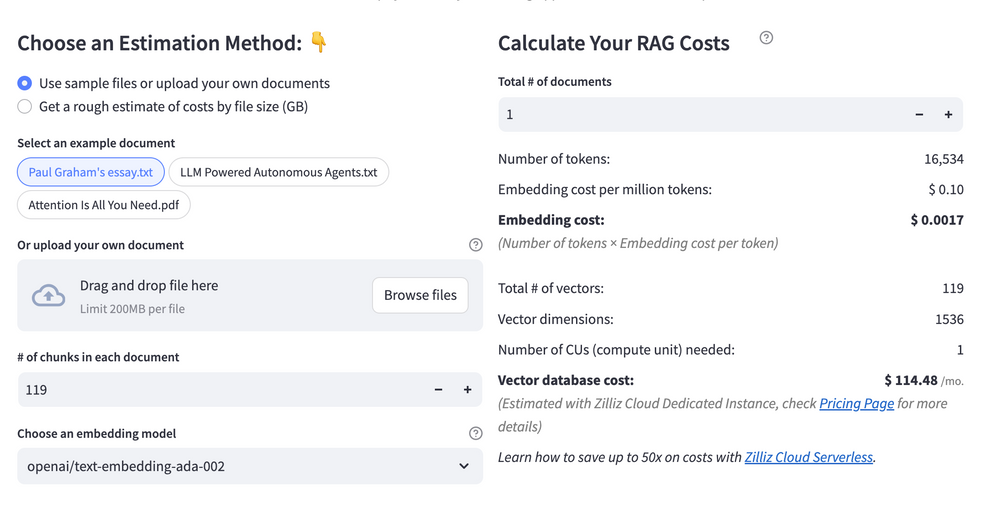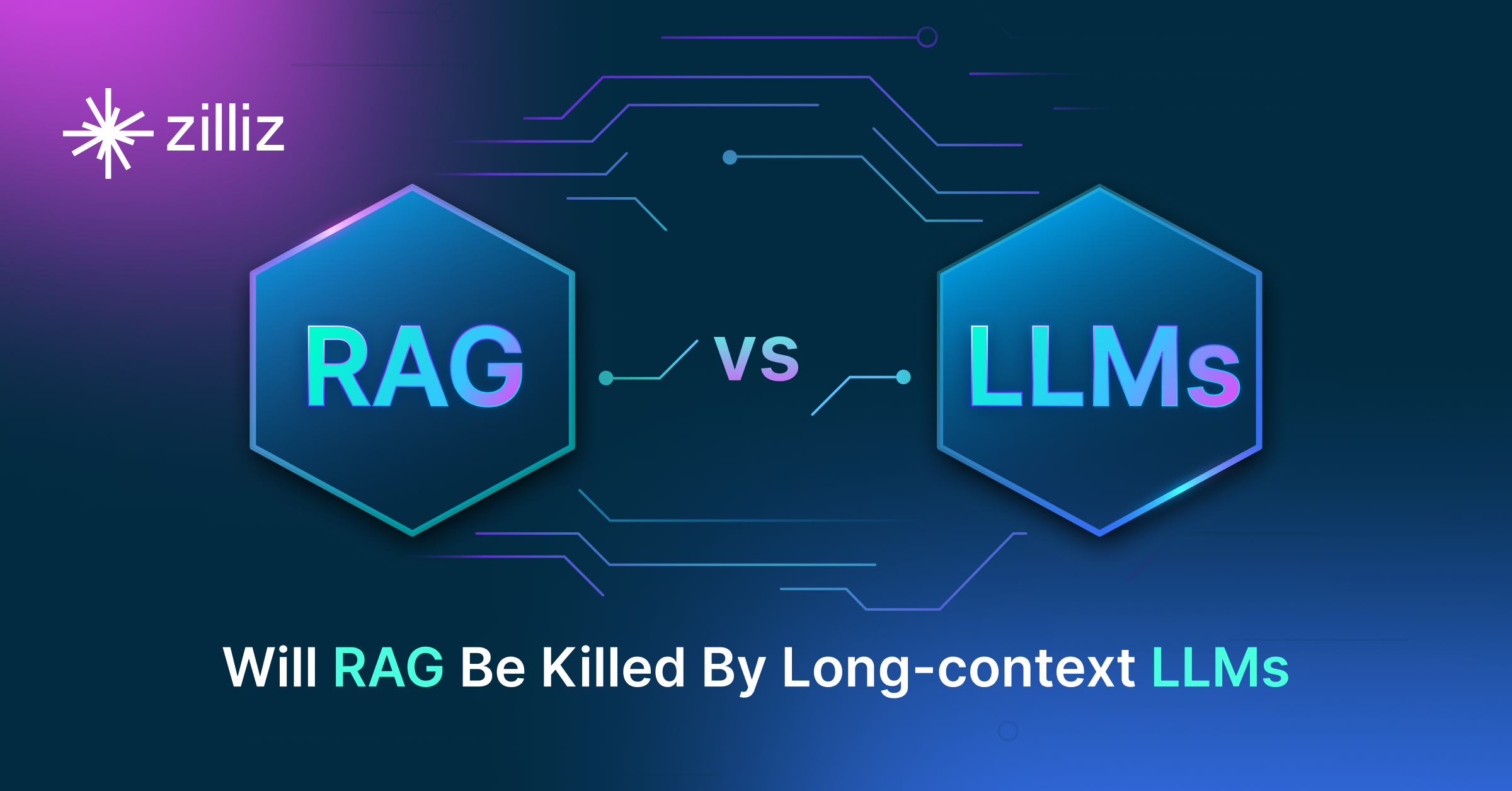Build RAG Chatbot with Llamaindex, Faiss, Anthropic Claude 3 Sonnet, and OpenAI text-embedding-3-small
Introduction to RAG
Retrieval-Augmented Generation (RAG) is a game-changer for GenAI applications, especially in conversational AI. It combines the power of pre-trained large language models (LLMs) like OpenAI’s GPT with external knowledge sources stored in vector databases such as Milvus and Zilliz Cloud, allowing for more accurate, contextually relevant, and up-to-date response generation. A RAG pipeline usually consists of four basic components: a vector database, an embedding model, an LLM, and a framework.
Key Components We'll Use for This RAG Chatbot
This tutorial shows you how to build a simple RAG chatbot in Python using the following components:
- Llamaindex: a data framework that connects large language models (LLMs) with various data sources, enabling efficient retrieval-augmented generation (RAG). It helps structure, index, and query private or external data, optimizing LLM applications for search, chatbots, and analytics.
- Faiss: also known as Facebook AI Similarity Search, is an open-source vector search library that allows developers to quickly search for semantically similar multimedia data within a massive dataset of unstructured data. (If you want a much more scalable solution or hate to manage your own infrastructure, we recommend using Zilliz Cloud, which is a fully managed vector database service built on the open-source Milvus and offers a free tier supporting up to 1 million vectors.)
- Anthropic Claude 3 Sonnet: A versatile AI model optimized for complex reasoning, multilingual tasks, and processing long-context inputs. It balances high performance with cost-efficiency, ideal for enterprise-scale applications like data analysis, real-time customer support, content creation, and research tasks requiring accuracy and scalability across diverse industries.
- OpenAI text-embedding-3-small: Designed to generate dense vector representations of text, this model excels in efficiency and cost-effectiveness, optimized for speed and low resource usage. It delivers competitive performance in semantic similarity, retrieval, and clustering tasks, making it ideal for large-scale applications like search engines, recommendation systems, and text classification where balancing accuracy with computational cost is crucial.
By the end of this tutorial, you’ll have a functional chatbot capable of answering questions based on a custom knowledge base.
Note: Since we may use proprietary models in our tutorials, make sure you have the required API key beforehand.
Step 1: Install and Set Up Llamaindex
pip install llama-index
Step 2: Install and Set Up Anthropic Claude 3 Sonnet
%pip install llama-index-llms-anthropic
from llama_index.llms.anthropic import Anthropic
# To customize your API key, do this
# otherwise it will lookup ANTHROPIC_API_KEY from your env variable
# llm = Anthropic(api_key="")
llm = Anthropic(model="claude-3-sonnet-20240229")
Step 3: Install and Set Up OpenAI text-embedding-3-small
%pip install llama-index-embeddings-openai
from llama_index.embeddings.openai import OpenAIEmbedding
embed_model = OpenAIEmbedding(
model="text-embedding-3-small",
)
Step 4: Install and Set Up Faiss
%pip install llama-index-vector-stores-faiss
from llama_index.core import (
SimpleDirectoryReader,
load_index_from_storage,
VectorStoreIndex,
StorageContext,
)
from llama_index.vector_stores.faiss import FaissVectorStore
vector_store = FaissVectorStore(faiss_index=faiss_index)
Step 5: Build a RAG Chatbot
Now that you’ve set up all components, let’s start to build a simple chatbot. We’ll use the Milvus introduction doc as a private knowledge base. You can replace it with your own dataset to customize your RAG chatbot.
import requests
from llama_index.core import SimpleDirectoryReader
# load documents
url = 'https://raw.githubusercontent.com/milvus-io/milvus-docs/refs/heads/v2.5.x/site/en/about/overview.md'
example_file = 'example_file.md' # You can replace it with your own file paths.
response = requests.get(url)
with open(example_file, 'wb') as f:
f.write(response.content)
documents = SimpleDirectoryReader(
input_files=[example_file]
).load_data()
print("Document ID:", documents[0].doc_id)
storage_context = StorageContext.from_defaults(vector_store=vector_store)
index = VectorStoreIndex.from_documents(
documents, storage_context=storage_context, embed_model=embed_model
)
query_engine = index.as_query_engine(llm=llm)
res = query_engine.query("What is Milvus?") # You can replace it with your own question.
print(res)
Example output
Milvus is a high-performance, highly scalable vector database designed to operate efficiently across various environments, from personal laptops to large-scale distributed systems. It is available as both open-source software and a cloud service. Milvus excels in managing unstructured data by converting it into numerical vectors through embeddings, which facilitates fast and scalable searches and analytics. The database supports a wide range of data types and offers robust data modeling capabilities, allowing users to organize their data effectively. Additionally, Milvus provides multiple deployment options, including a lightweight version for quick prototyping and a distributed version for handling massive data scales.
Optimization Tips
As you build your RAG system, optimization is key to ensuring peak performance and efficiency. While setting up the components is an essential first step, fine-tuning each one will help you create a solution that works even better and scales seamlessly. In this section, we’ll share some practical tips for optimizing all these components, giving you the edge to build smarter, faster, and more responsive RAG applications.
LlamaIndex optimization tips
To optimize LlamaIndex for a Retrieval-Augmented Generation (RAG) setup, structure your data efficiently using hierarchical indices like tree-based or keyword-table indices for faster retrieval. Use embeddings that align with your use case to improve search relevance. Fine-tune chunk sizes to balance context length and retrieval precision. Enable caching for frequently accessed queries to enhance performance. Optimize metadata filtering to reduce unnecessary search space and improve speed. If using vector databases, ensure indexing strategies align with your query patterns. Implement async processing to handle large-scale document ingestion efficiently. Regularly monitor query performance and adjust indexing parameters as needed for optimal results.
Faiss Optimization Tips
To enhance the performance of the Faiss library in a Retrieval-Augmented Generation (RAG) system, begin by selecting the appropriate index type based on your data volume and query speed requirements; for example, using an IVF (Inverted File) index can significantly speed up queries on large datasets by reducing the search space. Optimize your indexing process by using the nlist parameter to partition data into smaller clusters and set an appropriate number of probes (nprobe) during retrieval to balance between speed and accuracy. Ensure the vectors are properly normalized and consider using 16-bit or 8-bit quantization during indexing to reduce memory footprints for large datasets while maintaining reasonable retrieval accuracy. Additionally, consider leveraging GPU acceleration if available, as Faiss highly benefits from parallel processing, leading to faster nearest neighbor searches. Continuous fine-tuning and benchmarking with varying parameters and configurations can guide you in finding the most efficient setup specific to your data characteristics and retrieval requirements.
Anthropic Claude 3 Sonnet optimization tips
To optimize Claude 3 Sonnet in RAG workflows, refine retrieval chunk sizes to balance context relevance and token efficiency—aim for 500-800 token chunks with 15% overlap. Use structured prompts with XML tags or markdown to separate instructions from retrieved content, explicitly directing Claude to ground responses in provided sources. Lower temperature (0.2-0.4) improves factual consistency, while adding validation steps like “Verify this answer is fully supported by the context” reduces hallucinations. Prioritize system prompts to define response formats and enforce source citation. Test top-p (0.7-0.9) and max tokens to control output breadth without truncation.
OpenAI text-embedding-3-small optimization tips
Optimize input text by truncating or chunking to stay within the 8191-token limit while preserving semantic context. Normalize embeddings to unit vectors to improve cosine similarity accuracy. Batch embedding requests to reduce API calls and latency. Experiment with dimensionality reduction (e.g., 256-dim) to balance performance and storage costs. Preprocess text by removing redundant or noisy content and standardizing formats (lowercase, trimming whitespace). Cache frequent or static embeddings to avoid redundant computations. Monitor retrieval quality via metrics like recall@k and adjust chunking strategies or hybrid retrieval methods if needed. Fine-tune temperature and top-k parameters during generation to align with embedding outputs.
By implementing these tips across your components, you'll be able to enhance the performance and functionality of your RAG system, ensuring it’s optimized for both speed and accuracy. Keep testing, iterating, and refining your setup to stay ahead in the ever-evolving world of AI development.
RAG Cost Calculator: A Free Tool to Calculate Your Cost in Seconds
Estimating the cost of a Retrieval-Augmented Generation (RAG) pipeline involves analyzing expenses across vector storage, compute resources, and API usage. Key cost drivers include vector database queries, embedding generation, and LLM inference.
RAG Cost Calculator is a free tool that quickly estimates the cost of building a RAG pipeline, including chunking, embedding, vector storage/search, and LLM generation. It also helps you identify cost-saving opportunities and achieve up to 10x cost reduction on vector databases with the serverless option.
 Calculate your RAG cost
Calculate your RAG cost
What Have You Learned?
Congratulations on completing this tutorial! Throughout our journey, you’ve harnessed the incredible capabilities of a framework like LlamaIndex, a powerful vector database such as Faiss, and cutting-edge tools like Anthropic Claude 3 Sonnet and OpenAI's text-embedding-3-small model to construct your very own Retrieval-Augmented Generation (RAG) system. You've learned how to seamlessly integrate these components into a cohesive pipeline—efficiently retrieving relevant information and enriching it with context through the mighty capabilities of large language models. With the knowledge gained here, you’re now equipped to create systems that can dynamically pull information and deliver insightful responses that feel tailored to each user's needs!
But that’s not all! You’ve also picked up valuable tips for optimizing your RAG pipeline, ensuring it runs smoothly and efficiently, and we're excited to introduce a free RAG cost calculator to help you manage and predict your resource expenses effectively. As you step forward, remember that the world of technology is your playground, and the skills you’ve learned here serve as a solid foundation. So go ahead—start building, optimizing, and innovating your own unique RAG applications! The possibilities are endless, and with your newfound knowledge, we can’t wait to see the fantastic solutions you’ll create. Happy building!
Further Resources
🌟 In addition to this RAG tutorial, unleash your full potential with these incredible resources to level up your RAG skills.
- How to Build a Multimodal RAG | Documentation
- How to Enhance the Performance of Your RAG Pipeline
- Graph RAG with Milvus | Documentation
- How to Evaluate RAG Applications - Zilliz Learn
- Generative AI Resource Hub | Zilliz
We'd Love to Hear What You Think!
We’d love to hear your thoughts! 🌟 Leave your questions or comments below or join our vibrant Milvus Discord community to share your experiences, ask questions, or connect with thousands of AI enthusiasts. Your journey matters to us!
If you like this tutorial, show your support by giving our Milvus GitHub repo a star ⭐—it means the world to us and inspires us to keep creating! 💖
- Introduction to RAG
- Key Components We'll Use for This RAG Chatbot
- Step 1: Install and Set Up Llamaindex
- Step 2: Install and Set Up Anthropic Claude 3 Sonnet
- Step 3: Install and Set Up OpenAI text-embedding-3-small
- Step 4: Install and Set Up Faiss
- Step 5: Build a RAG Chatbot
- Optimization Tips
- RAG Cost Calculator: A Free Tool to Calculate Your Cost in Seconds
- What Have You Learned?
- Further Resources
- We'd Love to Hear What You Think!
Content
Vector Database at Scale
Zilliz Cloud is a fully-managed vector database built for scale, perfect for your RAG apps.
Try Zilliz Cloud for Free


